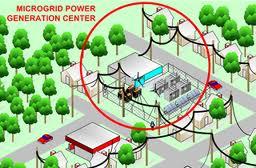GridOne solution to the aging U.S. grid: microgrids
Most Americans do not have to think much about energy reliability; they plug in a computer and it powers up; they flip a switch and the lights come on; while very reliable today, the U.S. electricity grid is old and has gone at least five decades without a significant technological upgrade. The U.S. Department of Energy’s National Renewable Energy Laboratory is working with industry on one solution to help maintain a secure, reliable flow of energy: microgrids

Microgrids can supply power during a outtage, or supplement the current supply // Source: illinois.edu
Most Americans do not have to think much about energy reliability. We plug in a computer and it powers up; we flip a switch and the lights come on.
While very reliable today, the U.S. electricity grid is old and has gone at least five decades without a significant technological upgrade. The U.S. Department of Energy’s (DOE) National Renewable Energy Laboratory (NREL) says it is working with industry on one solution to help maintain a secure, reliable flow of energy: microgrids.
An NREL release notes that a microgrid is a smaller power grid that can operate either by itself or connected to a larger utility grid. Microgrids can serve areas as small as a few houses, all the way up to large military installations.
“If your home was part of a microgrid, you could continue to receive power even when the utility power goes out,” NREL Electrical Engineer Mariko Shirazi said. “It gives you the ability to ride through any disturbances or outages by seamlessly switching over to locally generated power.”
It is important to note that a backup power system — like a diesel generator — is not the same as a microgrid. Backup generators supply power to local loads in the event of an outage, but there is usually a delay or blip when you lose power and disconnect from the utility grid before the backup kicks in. In addition, a backup system is never meant to run continuously, nor to put power into the grid. However, the reverse is true — a microgrid can serve as a backup power supply.
A microgrid senses the quality of the power flowing through the grid. In the event of an outage, it can disconnect from the grid at a moment’s notice. It can also leverage solar, wind, or stored energy to supplement a dip in the current power supply. If things are running smoothly with the regional grid, a microgrid generating electricity from renewable sources can export that clean energy to the grid for everyone’s use.
The major components of a microgrid include a source of power generation, local loads, and electrical switching gear. It might also include inverters and energy storage — all of which sounds easy enough to just connect up to get started, right?
“These technologies are in different stages of maturity; the challenge is to get them all to operate together in a stable, concerted way to accomplish the goals of
